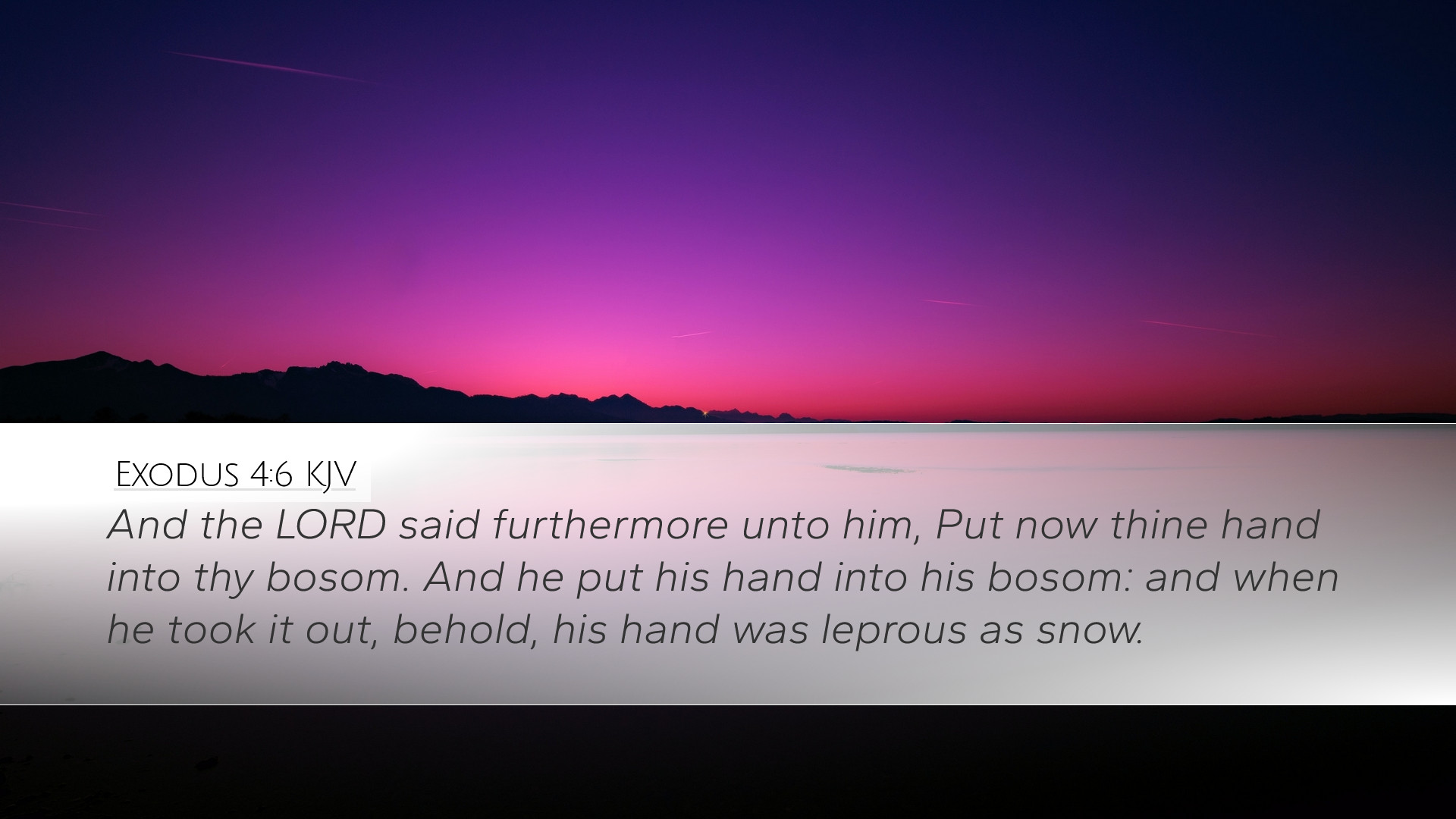Commentary on Exodus 4:6
Verse: Exodus 4:6 - "And the Lord said furthermore unto him, Put now thine hand into thy bosom. And he put his hand into his bosom: and when he took it out, behold, his hand was leprous as snow."
Introduction
This verse forms part of the narrative in which God calls Moses to deliver the Israelites from Egypt. The miraculous signs given to Moses serve to strengthen his faith and provide evidence of divine authority for his mission. The incident of Moses’ hand becoming leprous carries rich theological and practical implications. Key commentaries enhance our understanding of this profound moment.
Meditations on the Verse
The Significance of the Sign
Matthew Henry: Henry emphasizes the significance of God providing Moses with signs. He notes that the leprosy of the hand symbolizes sin and the human condition. Moses’ initial hesitance reflects our struggles with self-doubt, but God uses such moments to reveal His power and ability to purify.
Albert Barnes: Barnes discusses how the leprosy can be seen as indicative of the sinful state of humanity. This transformation emphasizes the need for divine intervention in restoring purity. Barnes also notes that the sign was aimed not merely to persuade Moses but to prepare him for his role as the deliverer, underscoring both Moses’ humanity and God’s omnipotence.
Adam Clarke: Clarke relates the leprous hand to God’s ability to change our condition dramatically. It signifies both judgment and grace. The act of placing the hand into the bosom symbolizes introspection and a revelation of hidden sin, which can only be dealt with through God’s power.
The Act of Obedience
Matthew Henry: The act of putting his hand into his bosom demonstrates obedience and faith. Henry points out that the unexpected result serves to teach Moses reliance on God’s command. It illustrates the principle that divine assistance often requires human cooperation.
Albert Barnes: Barnes asserts that true obedience sometimes leads Christians into situations where they encounter their weaknesses or failings. This act sets a precedent for the experiences Moses will face in his leadership and role in confronting Pharaoh.
Adam Clarke: Clarke observes that obedience is the precursor to seeing God's miraculous works. He stresses that it is in the act of submitting to God's commands that Moses experiences the profound transformation of his hand, which serves as a precursor to Moses’ further acts of faith.
Symbolism of Leprosy
Matthew Henry: Leprosy is a biblical metaphor for sin, and its sudden manifestation in the hand signifies the stark reality of sin’s presence in humanity. Henry relates this to how sin can corrupt the most valuable parts of human nature.
Albert Barnes: Barnes elaborates that the condition of leprosy aptly illustrates humanity's alienation from God due to sin. Just as leprosy isolates, so does sin create separation, underscoring the importance of redemption and restoration through divine grace.
Adam Clarke: Clarke extends the metaphor by suggesting that leprosy also serves as a reminder of God’s judgment on sin while offering hope for healing through repentance. The power of God to transform the leprous hand back to wholeness shows that even the gravest of conditions can be redeemed.
Lessons for Today
From Exodus 4:6, we learn several key lessons pertinent to contemporary believers:
- Awareness of Sin: Just as Moses was confronted with the leprosy of his hand, believers are to remain conscious of their own sinful states.
- Obedience to God’s Commands: The importance of obeying God even when the outcomes are unclear is a prominent lesson.
- Divine Power to Transform: The ability of God to heal and transform sinfulness paint a picture of hope and redemption available to all.
- Preparation for Service: God often prepares His servants through the revelation of their weaknesses, highlighting the grace necessary for effective ministry.
Conclusion
Exodus 4:6 serves as a reminder of God’s profound ability to reveal deep spiritual truths through tangible signs. Through the insights of Matthew Henry, Albert Barnes, and Adam Clarke, we see the multifaceted implications of Moses’ encounter with divine power and the symbolism of leprosy. This verse not only speaks to Moses’ preparation but also to the eternal truths concerning sin, obedience, and redemption that apply to all believers. Pastors, students, and scholars alike can find rich theological and practical applications from this critical moment in scripture.


